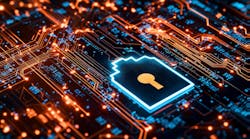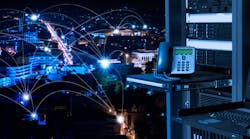Latest from Network Reliability/Testing & Assurance/Cybersecurity/Safety
The Power of Being Non-Intrusive
Real-Time Power Monitoring Creates Better Data Driven, Informed Decisions
The days of clamping a voltage tester or amp meter on a live wire to learn about power consumption are gone.
Today’s applications, and the revenue dependent upon their ongoing integrity, demand data. Accessing actionable real-time and historical data can establish the highest level of detail regarding power consumption, data that is crucial for event analysis, SLA enforcements, planning, trending, and engineering.
Old-school methods are cumbersome, less accurate and dependent upon physical presence in a location. Integrated controllers/monitors typically utilize a software-based (usually SNMP) network management system (NMS) to provide data 24/7 through remote, non-intrusive monitoring, enabling the archiving of historical data and short- and long-term analysis.
"…users can now make highly informed power-related infrastructure decisions, be proactive by recognizing potential equipment issues ahead of time, and gain ongoing, real-world data to analyze network trends more accurately than ever before—all with a relatively small investment in power monitoring."
So, what is the value in monitoring? Why should network engineers focus energy on this technology? Seven specific reasons are detailed below:
- Address Inefficiencies of Individual Components
Extensive reporting and alarming allow users to determine the actual current usage of individual components, enables powerful trend analysis, and gives insight into equipment performance to identify issues before they become a problem. - Set Threshold Alarms to be Informed Ahead of Time
Users can set threshold alarms for current, voltage, and temperature, providing notification of issues before fuses or breakers trip, enabling repair or replacement without service interruption. Alarms can help pinpoint a faulty fan, a degrading power supply, or failing backup equipment, for example. - Understand Power Use for Provisioning Purposes
Allocating and provisioning power for a specific application no longer relies on minimum/maximum specifications alone. Actual usage data, as well as short- and long-term tendencies, provide a concrete record to inform decisions. - Gain a Power Consumption Roadmap for Future Growth
Similarly, application engineers can utilize 24/7 monitoring to specify requirements for new power supplies, battery backup, and other costly equipment, ensuring a high level of future reliability. - Reduce Truck Rolls for Non-Critical Equipment
With real-time, 24/7 alerts, users can recognize issues with non-critical equipment and address them remotely, if possible, reducing the need for costly and time-consuming truck rolls. - Drill Into Detailed Energy Usage and Costs
As a cost management tool, remote, software-based power monitoring provides the data that reveals substandard equipment to target for replacement, as well as inefficient components that may be placing a strain on the power supply.
- Analyze Power Usage Comprehensively
A complete monitoring solution reports current per individual circuit, total input bus current, panel input voltage, and data from external temperature probes, creating a single, user-friendly platform for overall network power analysis.
Applications and Benefits
Power monitoring provides key information in any application. Here are a few real-world examples:
- Colocation
Power monitoring systems help to analyze power consumption for both sides of a colocation. With power and data delivered to the colo rack, the host can track usage of each individual circuit, while the customer/tenant has the ability to record how much power they’re actually utilizing.
Each side gains a clearer view of equipment and capacity requirements for the installation, as well as insight into equipment performance and notification of potential issues. One clear benefit for colocation tenants is the elimination of “over-purchasing” power, for example.
- Cell Sites
Real-time power monitoring provided insight into power usage at specific cell sites. Consider a site near a large apartment complex where engineers can monitor power usage to determine specific levels of power consumption when residents arrive home after work. This data can help determine an appropriately sized battery backup solution for the cell site, ultimately helping the provider build a better battery backup system for the installation.
- Data Centers/Central Offices
The amperage required to power larger installations can be staggering. Gaining real-time, detailed data through remote monitoring is a significantly more effective way of managing power in these high-investment, high-revenue applications.
As part of a power distribution panel, power monitoring solutions can record total power to the data center, as well as separately measuring power consumed by fans and other cooling equipment, servers, routers, and any other individual circuits/components in a single rack or the overall installation. Users can also capture data, analyze overall usage, and pinpoint potential problems at the circuit level.
There are numerous components and systems available that enable power monitoring, and while some utilize more traditional equipment, others make the most of technologies available today. One such system is nrgSMART™ from Amphenol Network Solutions. (See Figure 1.)
nrgSMART is an industry-first technology that integrates controller and monitoring functionality in compact power distribution panels. Its circuitry enables direct network connection to each individual panel, or the capability to interconnect multiple panels over secure serial cabling with a single network connection.
In addition to all of the advantages of real-time monitoring detailed above, an integrated power controller enables all this functionality without increasing the overall equipment footprint of the installation.
In other words, most applications require some type of power distribution panel; with an integrated controller, users need not sacrifice any additional rack space.
"With real-time, 24/7 alerts, users can recognize issues with non-critical equipment and address them remotely, if possible, reducing the need for costly and time-consuming truck rolls."
The Value of Power Monitoring
As mentioned earlier, there are many different solutions available for identifying power consumption, as well as providing data to support when it is necessary to increase capacity or change out problematic equipment. Choosing a system that provides all of the key functionality while also simplifying usage is the ideal option.
In today’s data-driven communications world, more engineers and network planners are recognizing the value of power monitoring. With the solutions available today, users can now make highly informed power-related infrastructure decisions, be proactive by recognizing potential equipment issues ahead of time, and gain ongoing, real-world data to analyze network trends more accurately than ever before—all with a relatively small investment in power monitoring.
ABOUT THE AUTHOR
Jon White is Product Manager, Amphenol Network Solutions. He has more than 20 years of experience in electronics and networks. For more information, please email [email protected] or visit amphenol-ns.com. You can also follow them on LinkedIn, Facebook, and Twitter @AmphenolNS.

Jon White
Jon White is Product Manager, Amphenol Network Solutions. He has more than 20 years of experience in electronics and networks. For more information, please email [email protected] or visit amphenol-ns.com. You can also follow us on LinkedIn, Facebook, and Twitter @AmphenolNS.





